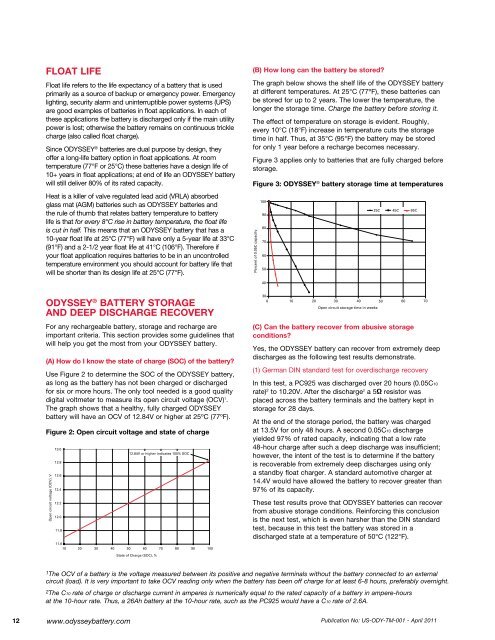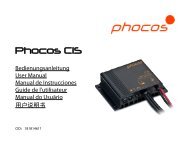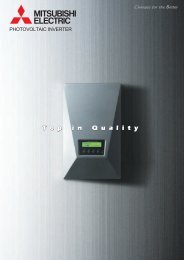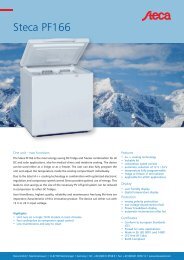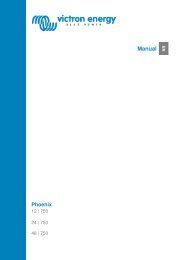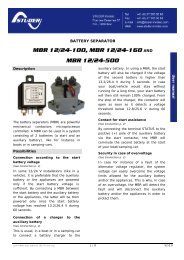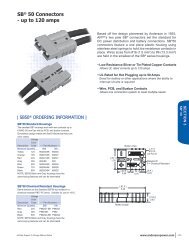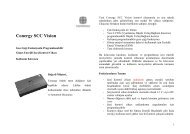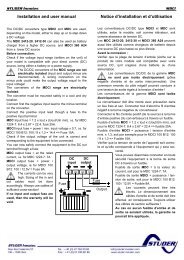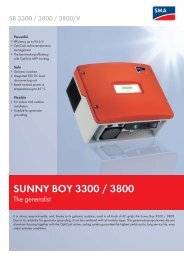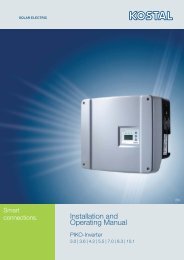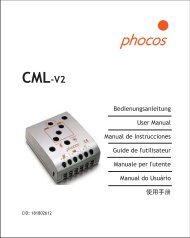Technical Manual - ODYSSEY Batteries
Technical Manual - ODYSSEY Batteries
Technical Manual - ODYSSEY Batteries
- No tags were found...
You also want an ePaper? Increase the reach of your titles
YUMPU automatically turns print PDFs into web optimized ePapers that Google loves.
Float lifeFloat life refers to the life expectancy of a battery that is usedprimarily as a source of backup or emergency power. Emergencylighting, security alarm and uninterruptible power systems (UPS)are good examples of batteries in float applications. In each ofthese applications the battery is discharged only if the main utilitypower is lost; otherwise the battery remains on continuous tricklecharge (also called float charge).Since <strong>ODYSSEY</strong> ® batteries are dual purpose by design, theyoffer a long-life battery option in float applications. At roomtemperature (77°F or 25°C) these batteries have a design life of10+ years in float applications; at end of life an <strong>ODYSSEY</strong> batterywill still deliver 80% of its rated capacity.(B) How long can the battery be stored?The graph below shows the shelf life of the <strong>ODYSSEY</strong> batteryat different temperatures. At 25°C (77ºF), these batteries canbe stored for up to 2 years. The lower the temperature, thelonger the storage time. Charge the battery before storing it.The effect of temperature on storage is evident. Roughly,every 10°C (18°F) increase in temperature cuts the storagetime in half. Thus, at 35°C (95°F) the battery may be storedfor only 1 year before a recharge becomes necessary.Figure 3 applies only to batteries that are fully charged beforestorage.Figure 3: <strong>ODYSSEY</strong> ® battery storage time at temperaturesHeat is a killer of valve regulated lead acid (VRLA) absorbedglass mat (AGM) batteries such as <strong>ODYSSEY</strong> batteries andthe rule of thumb that relates battery temperature to batterylife is that for every 8°C rise in battery temperature, the float lifeis cut in half. This means that an <strong>ODYSSEY</strong> battery that has a10-year float life at 25°C (77°F) will have only a 5-year life at 33°C(91°F) and a 2-1/2 year float life at 41°C (106°F). Therefore ifyour float application requires batteries to be in an uncontrolledtemperature environment you should account for battery life thatwill be shorter than its design life at 25°C (77°F).Percent of 0.05C capacity100908070605025C 45C 65C40<strong>ODYSSEY</strong> ® battery storageand deep discharge recovery30010 20 30 40 50 60 70Open circuit storage time in weeksFor any rechargeable battery, storage and recharge areimportant criteria. This section provides some guidelines thatwill help you get the most from your <strong>ODYSSEY</strong> battery.(A) How do I know the state of charge (SOC) of the battery?Use Figure 2 to determine the SOC of the <strong>ODYSSEY</strong> battery,as long as the battery has not been charged or dischargedfor six or more hours. The only tool needed is a good qualitydigital voltmeter to measure its open circuit voltage (OCV) 1 .The graph shows that a healthy, fully charged <strong>ODYSSEY</strong>battery will have an OCV of 12.84V or higher at 25ºC (77ºF).Figure 2: Open circuit voltage and state of chargeOpen circuit voltage (OCV), V13.012.812.612.412.212.011.812.84V or higher indicates 100% SOC11.610 20 30 40 50 60 70 80 90 100(C) Can the battery recover from abusive storageconditions?Yes, the <strong>ODYSSEY</strong> battery can recover from extremely deepdischarges as the following test results demonstrate.(1) German DIN standard test for overdischarge recoveryIn this test, a PC925 was discharged over 20 hours (0.05C10rate) 2 to 10.20V. After the discharge 2 a 5Ω resistor wasplaced across the battery terminals and the battery kept instorage for 28 days.At the end of the storage period, the battery was chargedat 13.5V for only 48 hours. A second 0.05C10 dischargeyielded 97% of rated capacity, indicating that a low rate48-hour charge after such a deep discharge was insufficient;however, the intent of the test is to determine if the batteryis recoverable from extremely deep discharges using onlya standby float charger. A standard automotive charger at14.4V would have allowed the battery to recover greater than97% of its capacity.These test results prove that <strong>ODYSSEY</strong> batteries can recoverfrom abusive storage conditions. Reinforcing this conclusionis the next test, which is even harsher than the DIN standardtest, because in this test the battery was stored in adischarged state at a temperature of 50°C (122°F).State of Charge (SOC), %1 The OCV of a battery is the voltage measured between its positive and negative terminals without the battery connected to an externalcircuit (load). It is very important to take OCV reading only when the battery has been off charge for at least 6-8 hours, preferably overnight.2 The C10 rate of charge or discharge current in amperes is numerically equal to the rated capacity of a battery in ampere-hoursat the 10-hour rate. Thus, a 26Ah battery at the 10-hour rate, such as the PC925 would have a C10 rate of 2.6A.12 www.odysseybattery.comPublication No: US-ODY-TM-001 - April 2011


